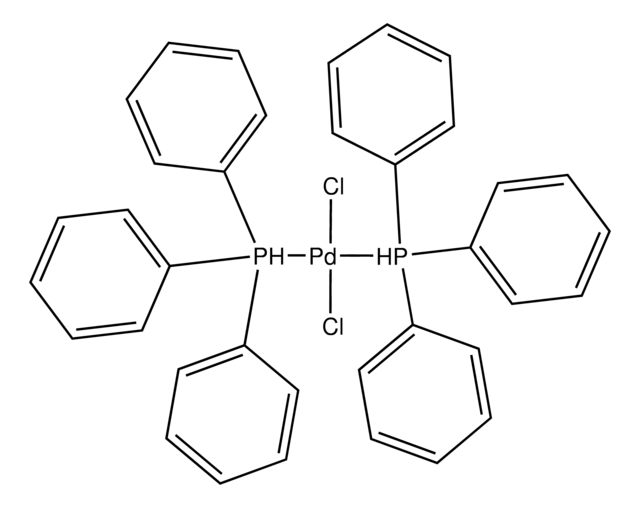We would recommend using a metallic scavenger like the QuadraPureTM products. Product numbers 655422 and 657662 are designed to scavenge palladium ions and are effective in both acidic and basic conditions. The resins are capable of removing metallic contamination to very low levels and are ideal for pharmaceutical or fine chemical processing.
推薦產品
品質等級
化驗
≥99.9% trace metals basis
反應適用性
core: palladium
reaction type: Buchwald-Hartwig Cross Coupling Reaction
reaction type: Cross Couplings
reaction type: Heck Reaction
reaction type: Hiyama Coupling
reaction type: Negishi Coupling
reaction type: Sonogashira Coupling
reaction type: Stille Coupling
reaction type: Suzuki-Miyaura Coupling
reagent type: catalyst
reaction type: C-H Activation
mp
216.3-223.7 °C (dec.)
SMILES 字串
CC(O[Pd]OC(C)=O)=O
InChI
1S/2C2H4O2.Pd/c2*1-2(3)4;/h2*1H3,(H,3,4);/q;;+2/p-2
InChI 密鑰
YJVFFLUZDVXJQI-UHFFFAOYSA-L
尋找類似的產品? 前往 產品比較指南
相關類別
一般說明
相關產品
訊號詞
Danger
危險聲明
危險分類
Aquatic Acute 1 - Aquatic Chronic 1 - Eye Dam. 1 - Skin Sens. 1A
儲存類別代碼
11 - Combustible Solids
水污染物質分類(WGK)
WGK 2
閃點(°F)
Not applicable
閃點(°C)
Not applicable
個人防護裝備
dust mask type N95 (US), Eyeshields, Gloves
客戶也查看了
文章
Heck反应是烯烃与芳基或乙烯基卤化物(或三氟甲磺酸酯)之间的钯催化交叉偶联反应,用于生成取代的烯烃。
-
When using are Product 520764, Palladium (II) acetate, what can I use to remove traces of palladium that this catalyst may leave behind?
1 answer-
Helpful?
-
-
What reactions are Product 520764, Palladium (II) acetate, used in?
1 answer-
Palladium (II) acetate is used as a catalyst for a number of reactions, including: Suzuki coupling reactions, (See ChemFiles 2.1 and ChemFiles 4.2) vinylation, (i.e. the Heck Reaction), rearrangement of acyclic dienes (i.e. the Cope Reaction).Papers that cite the use of this reagent are listed below. 1. B.M. Trost Tet. 33, 2615, (1977)2. R.F. Heck Acc. Chem. Res. 12, 146, (1979)3. Tet. 62, 9002, (2006)4. Org. Lett. 8, 3311, (2006) abstract5. Organometallic News 2, 52, (2002)
Helpful?
-
-
What atmosphere is Product 520764, Palladium (II) acetate, packaged under?
1 answer-
This material is packaged under a layer of nitrogen to reduce the chance of moisture contamination.
Helpful?
-
-
What is Product 520764, Palladium (II) acetate, soluble in?
1 answer-
Palladium acetate is not water-soluble; it is organic soluble. Although Sigma-Aldrich does not test solubility of 520764 directly, it is expected to be soluble in most common organic solvents, like chloroform, methylene chloride and acetone, according to the manufacturer.
Helpful?
-
-
What is the difference between Product 520764, Palladium (II) acetate, and the palladium acetate in the form of a ChemDose® tablet?
1 answer-
The ChemDose® products offer a streamlined way to catalyze reactions. The catalyst is dispersed in an inert tablet matrix in specific millimolar and micromolar quantities. The tablets can decrease time spent on weighing/adding the catalyst to the reaction mixture. The tablets effectively give the same reaction yields with a controlled release of the catalyst. They are also extremely easy to remove after the reaction is complete. The inert tablet usually stays intact throughout the reaction. Product 684929 is the ChemDose® tablet that contains 2.0 μmol of palladium (II) acetate, while product#: 685593 is the 10μmol version. More information on these products can be found at the link below.
Helpful?
-
-
What is the Department of Transportation shipping information for this product?
1 answer-
Transportation information can be found in Section 14 of the product's (M)SDS.To access the shipping information for this material, use the link on the product detail page for the product.
Helpful?
-
Active Filters
我們的科學家團隊在所有研究領域都有豐富的經驗,包括生命科學、材料科學、化學合成、色譜、分析等.
聯絡技術服務









![[Pd(acac)2] Umicore, 99%](/deepweb/assets/sigmaaldrich/product/structures/145/685/c3d0f078-c0c6-4ce6-9c4a-b6a1b973b3a9/640/c3d0f078-c0c6-4ce6-9c4a-b6a1b973b3a9.png)


